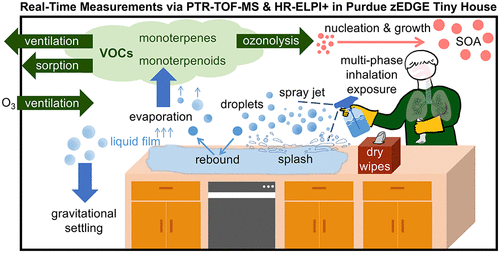当前位置:
X-MOL 学术
›
Environ. Sci. Technol. Lett.
›
论文详情
Our official English website, www.x-mol.net, welcomes your
feedback! (Note: you will need to create a separate account there.)
Real-Time Measurements of Botanical Disinfectant Emissions, Transformations, and Multiphase Inhalation Exposures in Buildings
Environmental Science & Technology Letters ( IF 8.9 ) Pub Date : 2021-06-09 , DOI: 10.1021/acs.estlett.1c00390 Jinglin Jiang 1, 2 , Xiaosu Ding 1 , Antonios Tasoglou 3 , Heinz Huber 4 , Amisha D. Shah 1, 5 , Nusrat Jung 1 , Brandon E. Boor 1, 2
Environmental Science & Technology Letters ( IF 8.9 ) Pub Date : 2021-06-09 , DOI: 10.1021/acs.estlett.1c00390 Jinglin Jiang 1, 2 , Xiaosu Ding 1 , Antonios Tasoglou 3 , Heinz Huber 4 , Amisha D. Shah 1, 5 , Nusrat Jung 1 , Brandon E. Boor 1, 2
Affiliation

|
Thymol-based botanical disinfectants have emerged as natural alternatives to traditional chemical disinfectants given their effectiveness as antimicrobial pesticides and ability to inactivate SARS-CoV-2. This study investigates the impact of botanical disinfectants on indoor air chemistry and human exposure. Controlled surface disinfection experiments were conducted in a mechanically ventilated zero-energy tiny house laboratory. Volatile organic compounds (VOCs) and aerosol size distributions were measured in real-time (1 Hz) with a proton transfer reaction time-of-flight mass spectrometer and a high-resolution electrical low-pressure impactor, respectively. Botanical disinfectant spray and wipe products drove sudden changes in the chemical composition of indoor air. Mixing ratios of monoterpenes (C10H16) and monoterpenoids (C10H14O, C10H16O, C10H18O, and C10H20O) increased suddenly during the disinfection events (10–1 to 102 ppb) and exhibited volatility-dependent temporal emission profiles. VOC emission factors ranged from 100 to 104 μg g–1, and thymol intake fractions ranged from 6 to 7 × 103 ppm. Rapid new particle formation events were observed due to ozonolysis of monoterpenes and monoterpenoids, increasing sub-100 nm particle number concentrations by 104 to 105 cm–3. Botanical disinfectant sprays initiated multiphase inhalation exposure to VOCs, secondary organic aerosol, and sub-10 μm droplets, with large deposited doses in each respiratory tract region associated with the latter two.
中文翻译:

建筑物中植物消毒剂排放、转化和多相吸入暴露的实时测量
鉴于百里酚类植物消毒剂作为抗菌杀虫剂的有效性和灭活 SARS-CoV-2 的能力,它们已成为传统化学消毒剂的天然替代品。本研究调查了植物消毒剂对室内空气化学和人体暴露的影响。受控表面消毒实验在机械通风的零能耗小房子实验室中进行。挥发性有机化合物 (VOC) 和气溶胶粒径分布分别使用质子转移反应飞行时间质谱仪和高分辨率电子低压冲击器实时测量 (1 Hz)。植物消毒喷雾和擦拭产品促使室内空气化学成分发生突然变化。单萜的混合比(C 10 H16 ) 和单萜类化合物(C 10 H 14 O、C 10 H 16 O、C 10 H 18 O 和 C 10 H 20 O)在消毒事件期间突然增加(10 –1到 10 2 ppb)并表现出依赖于挥发性时间排放剖面。VOC 排放因子的范围为 10 0至 10 4 μg g –1,百里酚摄入量的范围为 6 至 7 × 10 3 ppm。由于单萜和单萜类化合物的臭氧分解,观察到快速的新粒子形成事件,将亚 100 nm 粒子数浓度增加了 104到 10 5厘米–3 . 植物消毒剂喷雾引发了对 VOC、二次有机气溶胶和亚 10 μm 液滴的多相吸入暴露,在与后两者相关的每个呼吸道区域都有大量沉积剂量。
更新日期:2021-07-13
中文翻译:

建筑物中植物消毒剂排放、转化和多相吸入暴露的实时测量
鉴于百里酚类植物消毒剂作为抗菌杀虫剂的有效性和灭活 SARS-CoV-2 的能力,它们已成为传统化学消毒剂的天然替代品。本研究调查了植物消毒剂对室内空气化学和人体暴露的影响。受控表面消毒实验在机械通风的零能耗小房子实验室中进行。挥发性有机化合物 (VOC) 和气溶胶粒径分布分别使用质子转移反应飞行时间质谱仪和高分辨率电子低压冲击器实时测量 (1 Hz)。植物消毒喷雾和擦拭产品促使室内空气化学成分发生突然变化。单萜的混合比(C 10 H16 ) 和单萜类化合物(C 10 H 14 O、C 10 H 16 O、C 10 H 18 O 和 C 10 H 20 O)在消毒事件期间突然增加(10 –1到 10 2 ppb)并表现出依赖于挥发性时间排放剖面。VOC 排放因子的范围为 10 0至 10 4 μg g –1,百里酚摄入量的范围为 6 至 7 × 10 3 ppm。由于单萜和单萜类化合物的臭氧分解,观察到快速的新粒子形成事件,将亚 100 nm 粒子数浓度增加了 104到 10 5厘米–3 . 植物消毒剂喷雾引发了对 VOC、二次有机气溶胶和亚 10 μm 液滴的多相吸入暴露,在与后两者相关的每个呼吸道区域都有大量沉积剂量。











































 京公网安备 11010802027423号
京公网安备 11010802027423号